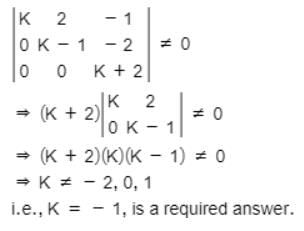Commerce Exam > Commerce Tests > Test: Solving Simultaneous Equations - Commerce MCQ
Test: Solving Simultaneous Equations - Commerce MCQ
Test Description
10 Questions MCQ Test - Test: Solving Simultaneous Equations
Test: Solving Simultaneous Equations for Commerce 2025 is part of Commerce preparation. The Test: Solving Simultaneous Equations questions and answers have been prepared
according to the Commerce exam syllabus.The Test: Solving Simultaneous Equations MCQs are made for Commerce 2025 Exam.
Find important definitions, questions, notes, meanings, examples, exercises, MCQs and online tests for Test: Solving Simultaneous Equations below.
Solutions of Test: Solving Simultaneous Equations questions in English are available as part of our course for Commerce & Test: Solving Simultaneous Equations solutions in
Hindi for Commerce course.
Download more important topics, notes, lectures and mock test series for Commerce Exam by signing up for free. Attempt Test: Solving Simultaneous Equations | 10 questions in 10 minutes | Mock test for Commerce preparation | Free important questions MCQ to study for Commerce Exam | Download free PDF with solutions
Test: Solving Simultaneous Equations - Question 1
The solution of the following system of equation is
2x + 3y = 5
5x – 2y = 3
2x + 3y = 5
5x – 2y = 3
Detailed Solution for Test: Solving Simultaneous Equations - Question 1
Test: Solving Simultaneous Equations - Question 2
One third of sum of two angles is 60° and one fourth of their difference is 28°. The angles are
Detailed Solution for Test: Solving Simultaneous Equations - Question 2
Test: Solving Simultaneous Equations - Question 3
For a square matrix A in a matrix equation AX = B, if │A│≠ 0, then
Detailed Solution for Test: Solving Simultaneous Equations - Question 3
Test: Solving Simultaneous Equations - Question 4
The following system of equations has
x + 3y + 3z = 2
x + 4y + 3z = 1
x + 3y + 4z = 2
Detailed Solution for Test: Solving Simultaneous Equations - Question 4
Detailed Solution for Test: Solving Simultaneous Equations - Question 5
Detailed Solution for Test: Solving Simultaneous Equations - Question 6
Test: Solving Simultaneous Equations - Question 7
The system of equations kx + 2y – z = 1,
(k – 1)y – 2z = 2
(k + 2)z = 3 has a unique solution, if k is
Detailed Solution for Test: Solving Simultaneous Equations - Question 7
Test: Solving Simultaneous Equations - Question 8
System of equations AX = B is inconsistent if
Detailed Solution for Test: Solving Simultaneous Equations - Question 8
Detailed Solution for Test: Solving Simultaneous Equations - Question 9
Test: Solving Simultaneous Equations - Question 10
A system of linear equations AX = B is said to be inconsistent, if the system of equations has
Detailed Solution for Test: Solving Simultaneous Equations - Question 10
Information about Test: Solving Simultaneous Equations Page
In this test you can find the Exam questions for Test: Solving Simultaneous Equations solved & explained in the simplest way possible.
Besides giving Questions and answers for Test: Solving Simultaneous Equations , EduRev gives you an ample number of Online tests for practice
Download as PDF















